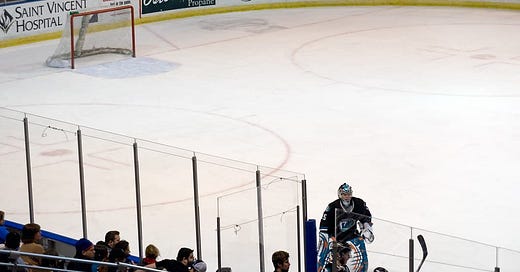Extra Attacker: When and How Should We Pull Our Goalie?
What to consider before pulling the goalie
Pulling the goalie is a tactical move to add a skater on the ice to try to overwhelm the defense. It’s a high-risk, high-reward proposition that deserves a nuanced analysis.
There are two basically two decisions that a coach needs to make:
How much time is left on the clock when we pull the goalie?
At what point in play should we pull the goalie?
Many of you likely saw the below clip of Vancouver Canucks forward J.T. Miller circling back with the puck and - rudely - gesturing for netminder Collin Delia to get off the ice. Miller’s thought process is simple; his team was in clear possession of the puck and thus he wanted the numerical advantage. We’ll come back to this concept in a bit.
Let’s Talk Math
Teams down one goal who pull their goaltender score around 15% of the time (roughly 1 out of 6 times) and increase their offensive output dramatically. From Meghan Hall's study and write-up, pulling the goalie effectively is the same as having a power play:
The New Jersey Devils Director Of Analytics, Matt Cane, wrote an article on whether teams should pull their goalies on the power play to play 6v4.
At 6v4 = nearly 12 goals per 60 minutes
At 6v5 = just shy of 6.5 goals per 60 minutes
Teams playing at 6v4 also give up empty net goals at a lower rate as well.
How Much Time Left When Pulling
Traditionally/historically, the rule of thumb was to pull the goalie with one minute left per goal needed.
Down 1 = Pull the goalie with 1-minute left
Down 2 = Pull the goalie with 2-minutes left
Down 3 = Pull the goalie with 3-minutes left
Currently, NHL teams are pulling their goalies earlier each season.
73 seconds remaining (2013-14)
97 seconds remaining (2020-21)
As established, teams are successful at scoring with the goalie pulled around 15% of the time. Relating that to pushing games to OT, Meghan found that successful outcomes tend to start with a more aggressive goalie pull.
Statistical analysis has shown that teams should be pulling their goalie even earlier than the rule of thumb. The first widespread research suggested that a team down one goal should pull their goalie with about six minutes (!) left.
Follow-up research suggests that a team should pull their goalie based on where the puck/faceoff is located.
In the offensive zone = Pull the goalie between 330 seconds and 550 seconds and put the goalie back when the puck is in the neutral or defensive zone.
In the neutral zone = Pull the goalie between 10 seconds and 330 seconds and put the goalie back when the puck is in the defensive zone.
In the defensive zone = Pull the goalie with around 10 to 20 seconds.
Based on this research, below is the optimal strategy when down by 1 goal
When down two goals, basically double the time… 1,180 seconds (OZ), 760 seconds (NZ), and 20 seconds (DZ).
How To Logistically Pull the Goalie
So, the math dictates that we should be pulling our goalie sooner. But the logistics of how we pull our goalie is more nuanced. Player availability, puck possession, puck location, and the team’s relative ability all come into the decision-making process.
An increasingly popular way of pulling the goalie is while in possession, regardless of where the puck is located. Coaches and players are no longer waiting until they are in the offensive zone.
Waiting until the team has confirmed the puck is located in the offensive zone is wasting 10 seconds or more without the extra player. That extra player would very likely help on the ensuing play and can stop the opposition in the case of a turnover.
Pulling Goalie Reality
Given the research and the practical realities, there are a few things we can take away and apply:
Coaches should have a feel for the game. Is our team controlling the play? Likely should pull the goalie earlier.
Pulling the goalie when your team has a power play with less than 3 minutes left also makes a ton of sense.
When pulling the goalie, understand the cost of waiting until clean possession. The sixth skater matters and can help win possession! They can help keep pucks in the offensive zone, apply pressure on the forecheck, and should be on the ice instead of waiting on the bench for a faceoff win.
Further Reading
Backchecking is a big part to winning hockey. What are the key details?
Players can create space for their teammates through ‘False Movement’







